by Gary Alexander
April 2, 2024
In the last business day of the quarter, the Bureau of Economic Analysis (BEA) told us that the U.S. economy grew by a robust 3.4% (annual rate) in the final quarter of 2023 and +2.5% for the full year.
Did the economy really grow by 3.4% in the last measurable quarter and 2.5% for the full year? We have some serious evidence to the contrary, to let’s take a closer look under the hood for a quarterly check-up.
As we have all heard, the American consumer accounts for 70% of GDP, and that’s the basic problem with that GDP calculation. It puts too much emphasis on the consumer, on retail sales. It focuses too closely on end demand, the ephemeral sentiment of the shopper. That’s why I like to wait for the end of each quarter, when the BEA also releases Gross Output (GO), a more expansive measure of growth, accounting for all of the various levels of production. By comparison to GDP, Gross Output in the last quarter and year has been more anemic, trailing GDP growth for the past few quarters, and that trend continued in the fourth quarter. “GO” was a full point below GDP in the fourth quarter, 2.4% vs. 3.4%,
Looking further back, business-to-business spending has been virtually flat since the start of 2022.
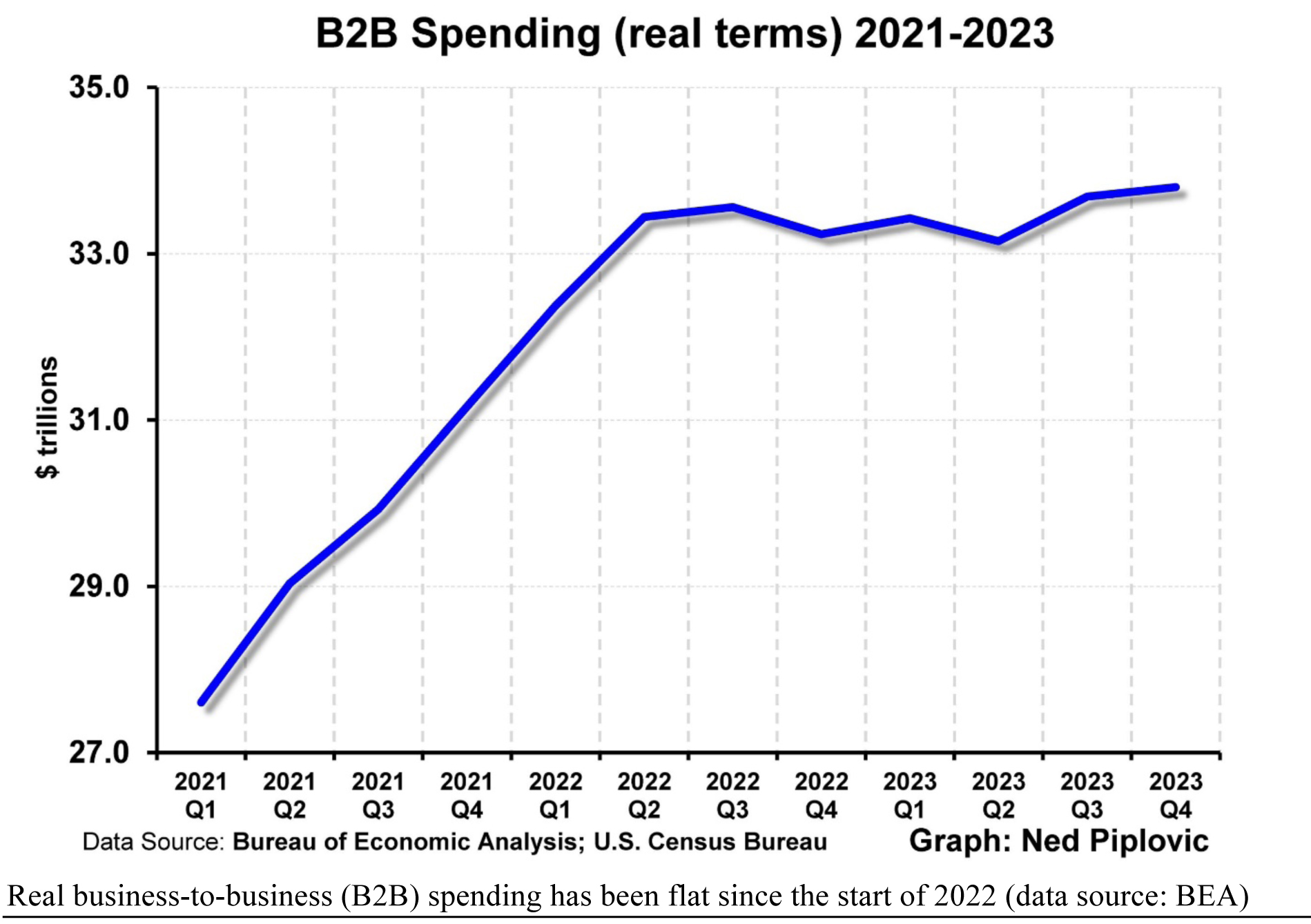
Graphs are for illustrative and discussion purposes only. Please read important disclosures at the end of this commentary.
This flat-lining indicates that the business sector – which is substantially larger than the retail sector and generally has a better view of the direction of the economy than consumers – is not on a growth trend.
Dr. Mark Skousen developed the theory behind Gross Output when he wrote his economic study of “The Structure of Production” in 1990 – at a time when I was his staff editor for his newsletter, “Forecasts and Strategies.” He kept promoting this total growth statistic for nearly 25 years before it was added to the National Output statistics in 2014, as reflected in his 2015 update to the book. The reason for this added measure, Skousen says, is that “B2B spending is in fact a pretty good indicator of where the economy is headed, since it is more responsive to the boom-bust economic cycle than consumer spending.”
While GDP includes only a small portion of investment spending, GO accounts for significantly more of total business investment outlays, which (as the next chart shows) makes the B2B index more volatile. This chart shows business spending’s larger leaps (vs. consumer spending) during the 2008 financial crisis, as well as its recent flat-lining, indicating a possible advance warning of a slowdown to come.
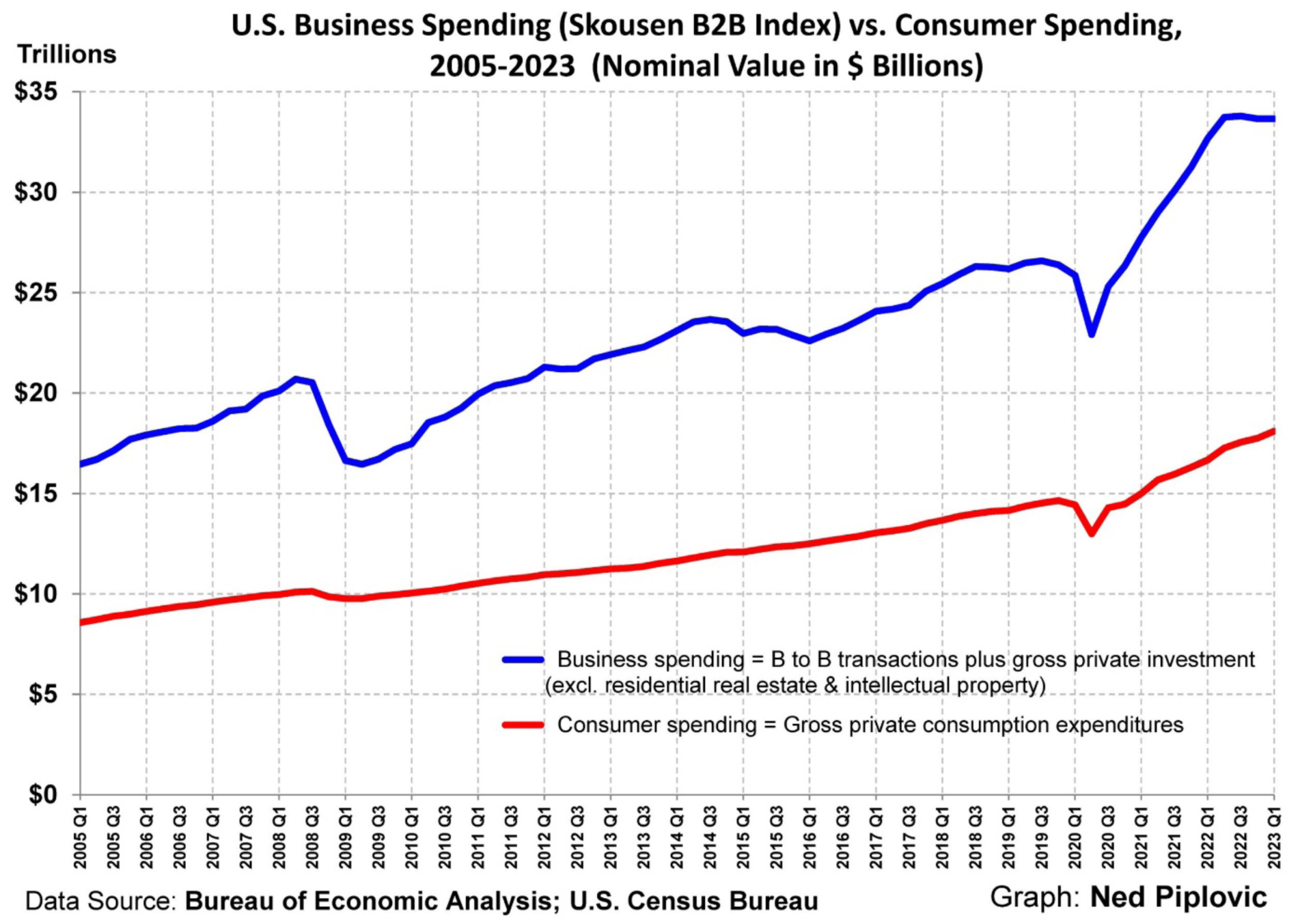
Graphs are for illustrative and discussion purposes only. Please read important disclosures at the end of this commentary.
One other aspect, evident in this chart, is that the blue line is almost double the red line, meaning that business spending (nearly $34 trillion) is almost double the level of consumer spending ($17 trillion). That means we no longer have to repeat the mantra, “the consumer is two-thirds of the economy.” We can say the consumer is two-thirds of GDP, but the consumer is more precisely one third of the economy.
Since GO tends to be a leading indicator, these latest data suggests we may be headed into a slowdown in the second half of 2024 – if not an outright recession. While consumer spending, by its nature, is fairly steady, businesses vary their spending depending on their view of anticipated future economic conditions.

Graphs are for illustrative and discussion purposes only. Please read important disclosures at the end of this commentary.
That’s what we’re seeing so far in 2024. Last week, the Atlanta Fed GDPNow model reduced its estimate for the first quarter of 2024 to 2.1%, while the Blue Chip economists predict a range of +1.0% to +2.5%.
Now, let’s turn to likely April market performance, as first-quarter earnings season is about to commence:
April Market Seasonality: Will the Winning Streak Continue?

T.S. Eliot was not a gifted market timer. He opened his vast (434-line) epic poem, “The Waste Land,” with the line quoted above, but when it was published at the start of 1923, the stock market began to soar in “The Roaring 20s,” and over the subsequent century, April was one of the market’s least cruel months.
Bespoke Investment Group has tabulated the fact that April is the best-performing month of the last 50 years, averaging 2.2% each April since the bear market of 1973-74, and since the publication of “The Waste Land,” it trails #1-July and sits just behind December as the second-best month since 1923.
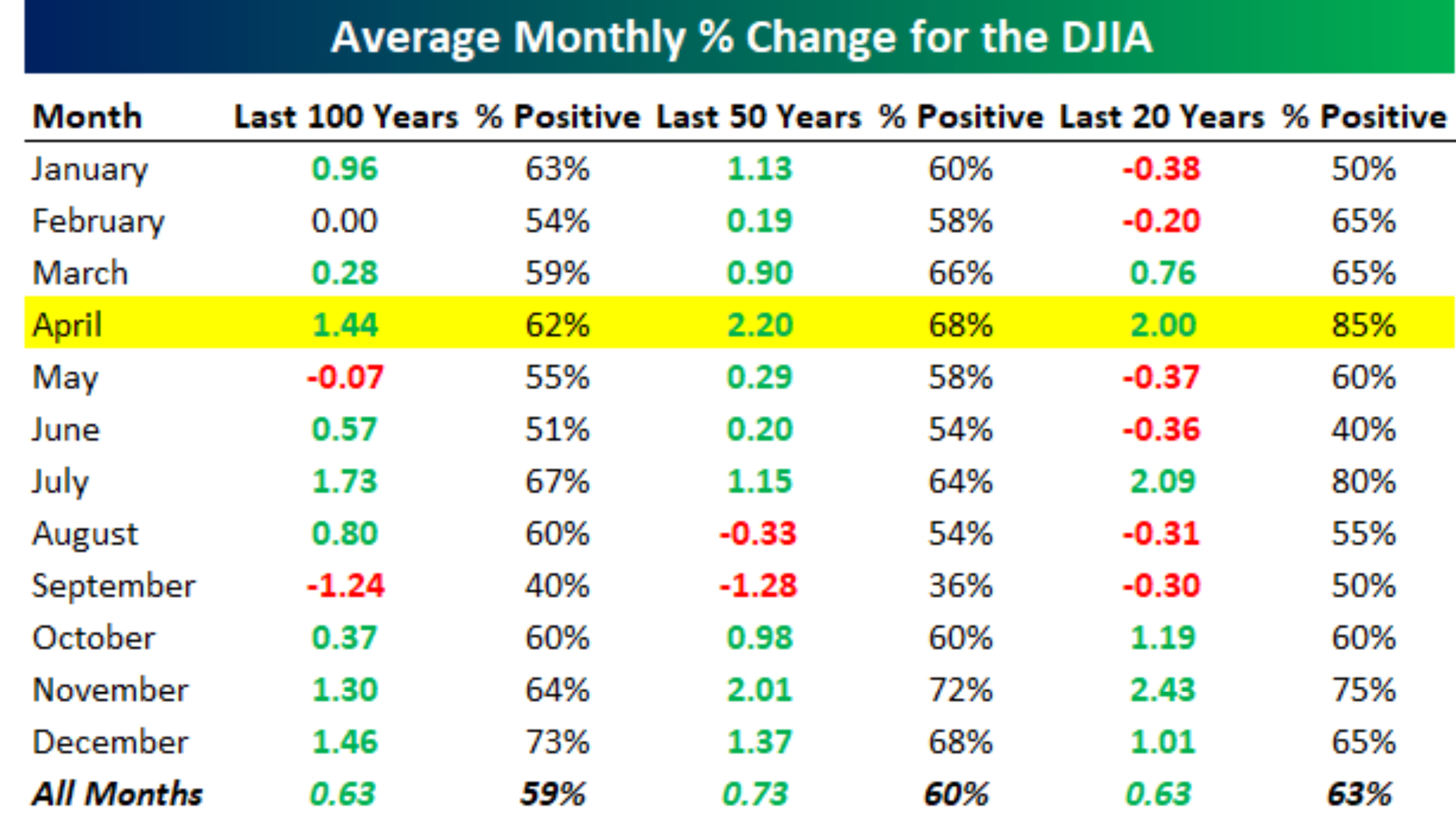
Graphs are for illustrative and discussion purposes only. Please read important disclosures at the end of this commentary.
The chart below shows the same data as the table above in a bar-chart forma.
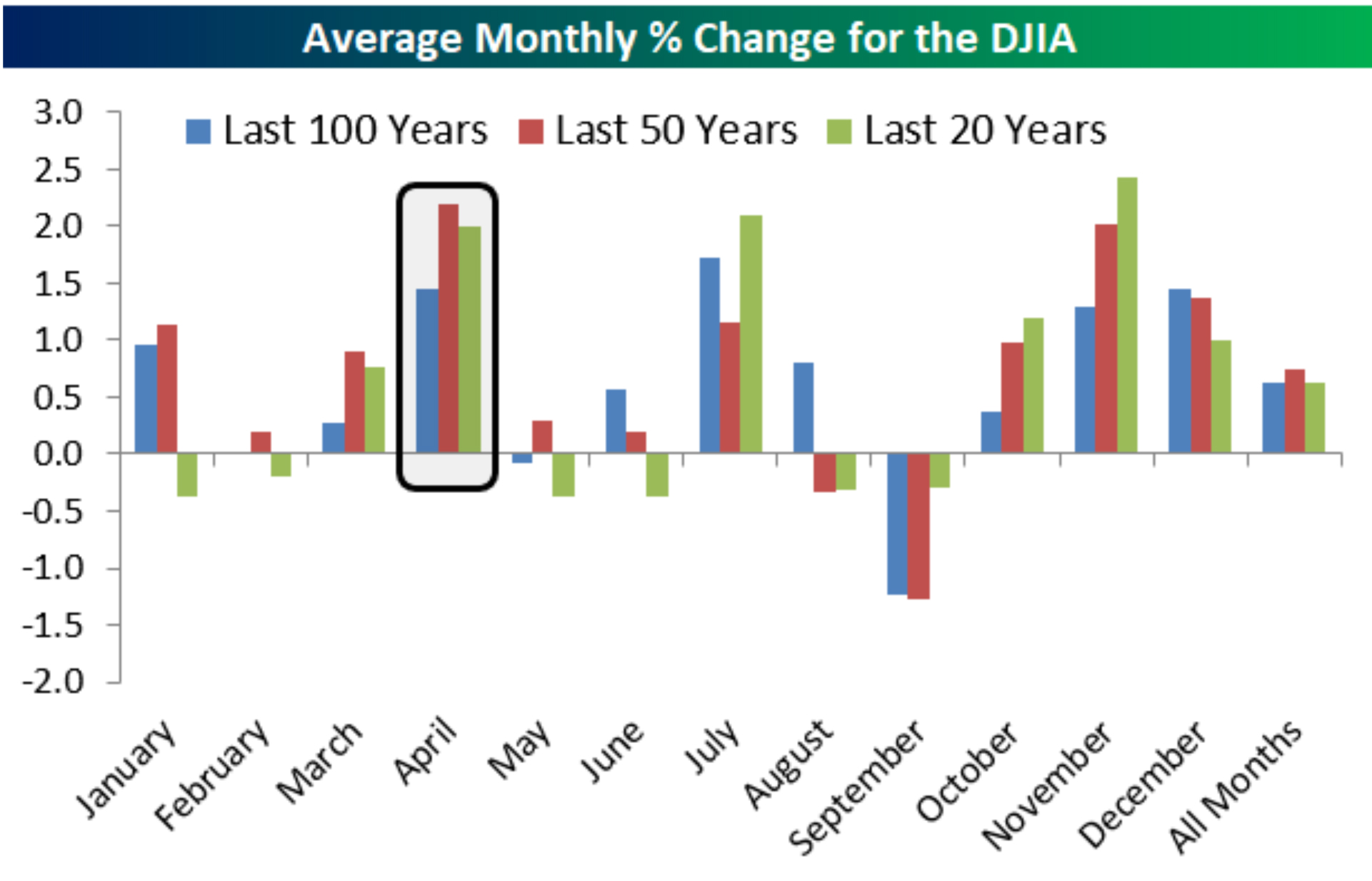
Source: Bespoke Investment Group
Graphs are for illustrative and discussion purposes only. Please read important disclosures at the end of this commentary.
Here’s another oddity about this April, courtesy of Bespoke. The S&P 500 closed March up 3.1%, making it the fifth straight month registering S&P gains of at least 1% per month. In fact, we have seen some mouth-watering cumulative gains of 27.6% since the lows of October 27, 2023. Here they are, by month:

The market doesn’t gain 1% or more in five consecutive months very often. In the nearly 80 years since 1945, this winning streak has only happened 12 previous times, and the market is always positive over the next 12 months, averaging another +14.3% gain from the end of the fifth consecutive 1%+ rising month.

Graphs are for illustrative and discussion purposes only. Please read important disclosures at the end of this commentary.
This doesn’t mean April 2024 is a lock. In fact, this list makes it a virtual toss-up, with seven rising months and five falling months, and one of those rising months (1991) is near zero (+0.03%), so there is no guarantee that this April will keep the streak alive, but 12 out of 12 rising years is promising indeed.
Ironically, you would think that April would perform better in the second half of the month, due to (1) the beginning of earnings season reports, and (2) post-tax season relief buying, but the record shows that the first 18 days of April contain nearly all of the net gains in the S&P 500 for Aprils over the last 70 years:
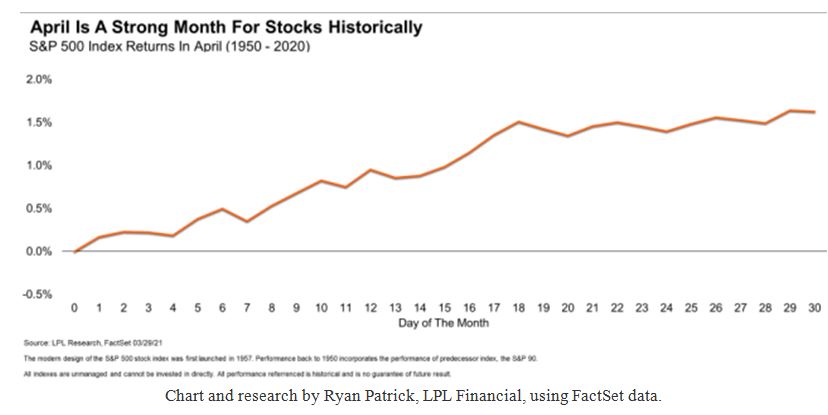
Graphs are for illustrative and discussion purposes only. Please read important disclosures at the end of this commentary.
P.S. All Hail NATO at 75
This week marks a notable birthday.
On April 4, 1949, the North American Treaty Organization (NATO) was founded in Washington, DC, by representatives of the U.S., Canada, and 10 West European nations. It was designed to stop the advance of Russia. NATO eventually expanded to 30 European states, plus the U.S. and Canada, with headquarters in Brussels. It certainly worked its magic during the 40 years of the Cold War in Europe before the fall of the Berlin Wall in 1989, but its purpose and funding have been sometimes vague and sporadic since then.
All content above represents the opinion of Gary Alexander of Navellier & Associates, Inc.
Also In This Issue
A Look Ahead by Louis Navellier
Food and Energy – The Overlooked Inflation Drivers
Income Mail by Bryan Perry
A Changing of the Market’s Guard
Growth Mail by Gary Alexander
Is the Economy Really Growing at a Robust 3.4%?
Global Mail by Ivan Martchev
Stocks Are Partying Like It is 1995
Sector Spotlight by Jason Bodner
Raiders of the Lost Art of Investing
View Full Archive
Read Past Issues Here
About The Author

Gary Alexander
SENIOR EDITOR
Gary Alexander has been Senior Writer at Navellier since 2009. He edits Navellier’s weekly Marketmail and writes a weekly Growth Mail column, in which he uses market history to support the case for growth stocks. For the previous 20 years before joining Navellier, he was Senior Executive Editor at InvestorPlace Media (formerly Phillips Publishing), where he worked with several leading investment analysts, including Louis Navellier (since 1997), helping launch Louis Navellier’s Blue Chip Growth and Global Growth newsletters.
Prior to that, Gary edited Wealth Magazine and Gold Newsletter and wrote various investment research reports for Jefferson Financial in New Orleans in the 1980s. He began his financial newsletter career with KCI Communications in 1980, where he served as consulting editor for Personal Finance newsletter while serving as general manager of KCI’s Alexandria House book division. Before that, he covered the economics beat for news magazines. All content of “Growth Mail” represents the opinion of Gary Alexander
Important Disclosures:
Although information in these reports has been obtained from and is based upon sources that Navellier believes to be reliable, Navellier does not guarantee its accuracy and it may be incomplete or condensed. All opinions and estimates constitute Navellier’s judgment as of the date the report was created and are subject to change without notice. These reports are for informational purposes only and are not a solicitation for the purchase or sale of a security. Any decision to purchase securities mentioned in these reports must take into account existing public information on such securities or any registered prospectus.To the extent permitted by law, neither Navellier & Associates, Inc., nor any of its affiliates, agents, or service providers assumes any liability or responsibility nor owes any duty of care for any consequences of any person acting or refraining to act in reliance on the information contained in this communication or for any decision based on it.
Past performance is no indication of future results. Investment in securities involves significant risk and has the potential for partial or complete loss of funds invested. It should not be assumed that any securities recommendations made by Navellier. in the future will be profitable or equal the performance of securities made in this report. Dividend payments are not guaranteed. The amount of a dividend payment, if any, can vary over time and issuers may reduce dividends paid on securities in the event of a recession or adverse event affecting a specific industry or issuer.
None of the stock information, data, and company information presented herein constitutes a recommendation by Navellier or a solicitation to buy or sell any securities. Any specific securities identified and described do not represent all of the securities purchased, sold, or recommended for advisory clients. The holdings identified do not represent all of the securities purchased, sold, or recommended for advisory clients and the reader should not assume that investments in the securities identified and discussed were or will be profitable.
Information presented is general information that does not take into account your individual circumstances, financial situation, or needs, nor does it present a personalized recommendation to you. Individual stocks presented may not be suitable for every investor. Investment in securities involves significant risk and has the potential for partial or complete loss of funds invested. Investment in fixed income securities has the potential for the investment return and principal value of an investment to fluctuate so that an investor’s holdings, when redeemed, may be worth less than their original cost.
One cannot invest directly in an index. Index is unmanaged and index performance does not reflect deduction of fees, expenses, or taxes. Presentation of Index data does not reflect a belief by Navellier that any stock index constitutes an investment alternative to any Navellier equity strategy or is necessarily comparable to such strategies. Among the most important differences between the Indices and Navellier strategies are that the Navellier equity strategies may (1) incur material management fees, (2) concentrate its investments in relatively few stocks, industries, or sectors, (3) have significantly greater trading activity and related costs, and (4) be significantly more or less volatile than the Indices.
ETF Risk: We may invest in exchange traded funds (“ETFs”) and some of our investment strategies are generally fully invested in ETFs. Like traditional mutual funds, ETFs charge asset-based fees, but they generally do not charge initial sales charges or redemption fees and investors typically pay only customary brokerage fees to buy and sell ETF shares. The fees and costs charged by ETFs held in client accounts will not be deducted from the compensation the client pays Navellier. ETF prices can fluctuate up or down, and a client account could lose money investing in an ETF if the prices of the securities owned by the ETF go down. ETFs are subject to additional risks:
- ETF shares may trade above or below their net asset value;
- An active trading market for an ETF’s shares may not develop or be maintained;
- The value of an ETF may be more volatile than the underlying portfolio of securities the ETF is designed to track;
- The cost of owning shares of the ETF may exceed those a client would incur by directly investing in the underlying securities; and
- Trading of an ETF’s shares may be halted if the listing exchange’s officials deem it appropriate, the shares are delisted from the exchange, or the activation of market-wide “circuit breakers” (which are tied to large decreases in stock prices) halts stock trading generally.
Grader Disclosures: Investment in equity strategies involves substantial risk and has the potential for partial or complete loss of funds invested. The sample portfolio and any accompanying charts are for informational purposes only and are not to be construed as a solicitation to buy or sell any financial instrument and should not be relied upon as the sole factor in an investment making decision. As a matter of normal and important disclosures to you, as a potential investor, please consider the following: The performance presented is not based on any actual securities trading, portfolio, or accounts, and the reported performance of the A, B, C, D, and F portfolios (collectively the “model portfolios”) should be considered mere “paper” or pro forma performance results based on Navellier’s research.
Investors evaluating any of Navellier & Associates, Inc.’s, (or its affiliates’) Investment Products must not use any information presented here, including the performance figures of the model portfolios, in their evaluation of any Navellier Investment Products. Navellier Investment Products include the firm’s mutual funds and managed accounts. The model portfolios, charts, and other information presented do not represent actual funded trades and are not actual funded portfolios. There are material differences between Navellier Investment Products’ portfolios and the model portfolios, research, and performance figures presented here. The model portfolios and the research results (1) may contain stocks or ETFs that are illiquid and difficult to trade; (2) may contain stock or ETF holdings materially different from actual funded Navellier Investment Product portfolios; (3) include the reinvestment of all dividends and other earnings, estimated trading costs, commissions, or management fees; and, (4) may not reflect prices obtained in an actual funded Navellier Investment Product portfolio. For these and other reasons, the reported performances of model portfolios do not reflect the performance results of Navellier’s actually funded and traded Investment Products. In most cases, Navellier’s Investment Products have materially lower performance results than the performances of the model portfolios presented.
This report contains statements that are, or may be considered to be, forward-looking statements. All statements that are not historical facts, including statements about our beliefs or expectations, are “forward-looking statements” within the meaning of The U.S. Private Securities Litigation Reform Act of 1995. These statements may be identified by such forward-looking terminology as “expect,” “estimate,” “plan,” “intend,” “believe,” “anticipate,” “may,” “will,” “should,” “could,” “continue,” “project,” or similar statements or variations of such terms. Our forward-looking statements are based on a series of expectations, assumptions, and projections, are not guarantees of future results or performance, and involve substantial risks and uncertainty as described in Form ADV Part 2A of our filing with the Securities and Exchange Commission (SEC), which is available at www.adviserinfo.sec.gov or by requesting a copy by emailing info@navellier.com. All of our forward-looking statements are as of the date of this report only. We can give no assurance that such expectations or forward-looking statements will prove to be correct. Actual results may differ materially. You are urged to carefully consider all such factors.
FEDERAL TAX ADVICE DISCLAIMER: As required by U.S. Treasury Regulations, you are informed that, to the extent this presentation includes any federal tax advice, the presentation is not written by Navellier to be used, and cannot be used, for the purpose of avoiding federal tax penalties. Navellier does not advise on any income tax requirements or issues. Use of any information presented by Navellier is for general information only and does not represent tax advice either express or implied. You are encouraged to seek professional tax advice for income tax questions and assistance.
IMPORTANT NEWSLETTER DISCLOSURE:The hypothetical performance results for investment newsletters that are authored or edited by Louis Navellier, including Louis Navellier’s Growth Investor, Louis Navellier’s Breakthrough Stocks, Louis Navellier’s Accelerated Profits, and Louis Navellier’s Platinum Club, are not based on any actual securities trading, portfolio, or accounts, and the newsletters’ reported hypothetical performances should be considered mere “paper” or proforma hypothetical performance results and are not actual performance of real world trades. Navellier & Associates, Inc. does not have any relation to or affiliation with the owner of these newsletters. There are material differences between Navellier Investment Products’ portfolios and the InvestorPlace Media, LLC newsletter portfolios authored by Louis Navellier. The InvestorPlace Media, LLC newsletters contain hypothetical performance that do not include transaction costs, advisory fees, or other fees a client might incur if actual investments and trades were being made by an investor. As a result, newsletter performance should not be used to evaluate Navellier Investment services which are separate and different from the newsletters. The owner of the newsletters is InvestorPlace Media, LLC and any questions concerning the newsletters, including any newsletter advertising or hypothetical Newsletter performance claims, (which are calculated solely by Investor Place Media and not Navellier) should be referred to InvestorPlace Media, LLC at (800) 718-8289.
Please note that Navellier & Associates and the Navellier Private Client Group are managed completely independent of the newsletters owned and published by InvestorPlace Media, LLC and written and edited by Louis Navellier, and investment performance of the newsletters should in no way be considered indicative of potential future investment performance for any Navellier & Associates separately managed account portfolio. Potential investors should consult with their financial advisor before investing in any Navellier Investment Product.
Navellier claims compliance with Global Investment Performance Standards (GIPS). To receive a complete list and descriptions of Navellier’s composites and/or a presentation that adheres to the GIPS standards, please contact Navellier or click here. It should not be assumed that any securities recommendations made by Navellier & Associates, Inc. in the future will be profitable or equal the performance of securities made in this report.
FactSet Disclosure: Navellier does not independently calculate the statistical information included in the attached report. The calculation and the information are provided by FactSet, a company not related to Navellier. Although information contained in the report has been obtained from FactSet and is based on sources Navellier believes to be reliable, Navellier does not guarantee its accuracy, and it may be incomplete or condensed. The report and the related FactSet sourced information are provided on an “as is” basis. The user assumes the entire risk of any use made of this information. Investors should consider the report as only a single factor in making their investment decision. The report is for informational purposes only and is not intended as an offer or solicitation for the purchase or sale of a security. FactSet sourced information is the exclusive property of FactSet. Without prior written permission of FactSet, this information may not be reproduced, disseminated or used to create any financial products. All indices are unmanaged and performance of the indices include reinvestment of dividends and interest income, unless otherwise noted, are not illustrative of any particular investment and an investment cannot be made in any index. Past performance is no guarantee of future results.
